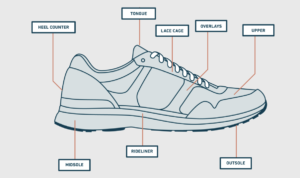SHOEGEAR
If you suffer from deteriorative arthritis, please Schedule an appointment with one of our orthopedic specialists as soon as possible.
What to Look For in a Functionally Supportive Shoe, What to Avoid!
Not all feet possess identical characteristics. Similar to body shapes, feet vary in shapes and sizes. As individuals age and accumulate more steps, their feet continuously adapt to their surroundings. Factors may undergo continual changes based on the number of steps taken, the terrain traversed, and the foot’s flexibility.
While individuals may not always control the terrain they encounter during walking, running, or exercising, they can certainly influence how their feet absorb energy from the ground up. This underscores the significance of appropriate shoe gear in preventing injuries, wear and tear, and discomfort. The definition of a “good” shoe may be subjective. However, functionally supportive footwear effectively safeguards the foot while absorbing ground reactive forces from both feet. Thereby facilitating pain-free strides throughout the gait cycle.
Shoegear Effectiveness
The effectiveness of a shoe hinges on the resilience and elasticity of its midsole. The first metatarsophalangeal joint, or the big toe joint, serves as the pivot point for the forces exerted by the lower leg—comprising the tibia, fibula, and calf muscle complex. In simple terms, when the midfoot and rearfoot joints, namely the tarsometatarsal joints and midtarsal joints, lack support from the outsole or midsole of the shoe, the foot expends greater energy during each push-off phase of the gait cycle.
Over time, directing increased energy and force to these joints may lead to injuries and early onset of arthritic symptoms, such as joint degeneration. Therefore, when selecting walking, hiking, or sports-specific shoes, it is crucial to assess the integrity of the midsole and outsole. If the midsole fails to regain its shape within one second after forceful bending and twisting at the midfoot level, the shoe’s effectiveness is significantly compromised.

Figure A. A simplified anatomy of a tennis shoe
Do I need Orthotics?
In short, orthotics can significantly bolster the arch or instep of your foot. While a good shoe may suffice for biomechanically advantageous feet in absorbing ground reactive forces, most individuals benefit from an orthotic that offers additional shock absorption and rearfoot control. When the midfoot and rearfoot possess biomechanical advantages, the legs, hips, and spine require less energy per stride. This reduces the risk of injury while maintaining optimal alignment and posture.
What type of orthotics should I get?
Please consult with your foot and ankle specialist to determine whether orthotics would be a good fit for your feet.

